Luton Corporation Tramways
History
Luton Corporation's standard-gauge, overhead electric tramway opened on the 21st February 1908, relatively late for a municipal system, especially so given that the corporation had owned its own power-generation plant since 1898.
After a few false starts involving tramway promoters, powers to build and operate a municipal tramway were eventually acquired by the corporation on the 11th August 1905, construction commencing a rather leisurely two years later on the 7th October 1907; the constructor — J G White and Company Limited — was, however, very experienced, so once started, it took a mere four months to complete, the system opening on the 21st February 1908. Operation of the tramway was also included in JGW&Co's contract, an arrangement that was also in place at Dartford Council Light Railways, which the corporation had visited and presumably been impressed with.
The tramway extended to 5.25 miles and though the original scheme included a greater mileage, it remained as built until its abandonment. The system was centred on the Town Hall, along George Street, and comprised five lines running: southeastwards along Park Street to Bailey Street, where the depot was situated; southwards along Chapel Street and Ashton Street to a terminus on London Road opposite Tennyson Road; northwestwards along Upper George Street and Dunstable Road to a terminus near the junction with Kingsway; and northwards along Manchester Street, where the route split, one line continuing northwards along New Bedford Road to Wardown and the other running eastwards then northeastwards along Midland Road and High Town Road to Round Green.
In May 1909 the lease, with the agreement of JGW&Co, was transferred to Balfour Beatty and Company, which had been set up that year — by George Balfour and Andrew Beatty — both of whom had worked for JGW&Co. The new company quickly set about promoting, purchasing or acquiring interests in several provincial tramways and electric supply companies across the country, a policy which would eventually see it control the following systems: 1909 (Dartford Council Light Railways; Dunfermline and District Tramways; Llandudno and Colwyn Bay Electric Railway; Llanelly Tramways; Luton Corporation Tramways); 1911 (City of Carlisle Electric Tramways); 1912 (Leamington and Warwick Electric Tramways; Mansfield and District Light Railway; Nottinghamshire and Derbyshire Tramways); 1914 (Cheltenham and District Light Railway); 1920 (Falkirk and District Tramways); and lastly, in 1922 (Wemyss and District Tramways).
Although passenger loadings were initially promising, the tramway soon began to struggle financially, a loss of £1000 being made by the operating company during the first full year of operations; as a consequence, it wasn't long before B&BCo resorted to running the system on a shoe string, an approach it also employed on several of its other struggling tramway systems. The original lease ran for either 5 or 15 years at the discretion of the council, so the company must have had mixed feelings when the council extended the lease to its full 15 years, the original 5 years finishing in February 1913.
Like most tramway systems, Luton's was badly affected by the exigencies of the Great War, with loss of staff (and skills), and an inability to source spares or to purchase new track or vehicles due to government restrictions. At one point, around half of the tramway fleet was out of action, which must have had a dramatic impact on services. The system emerged from the conflict in badly run-down condition, and despite a formal instruction from the corporation requiring the tramway company to bring the system into a good state of repair — by the 30th June 1919 — little if anything was done. As a result, a second notice was served on the company, which included a detailed list of the work needed, the contents constituting a damning indictment of the company's maintenance regime, which had over the course of ten years allowed the tramway to deteriorate alarmingly. The corporation eventually lost patience with the company, allowing the lease to run its full 15-year term, then taking over operation itself on the 21st February 1923.
The corporation made some effort to improve services and efficiency, purchasing a second-hand Glasgow Corporation Tramways vehicle, and fitting four of the open-top fleet with top covers, though not until 1929. Financial details are unclear, but it seems the corporation had some success with the system as good profits were returned during the mid 1920s, and even as late as 1929, the system was still being operated profitably. Track maintenance costs rose alarmingly as the system crept inexorably towards the time when it would either need significant investment to renew the track completely (and to modernise the tramcar fleet), or to replace it entirely with another mode of transport.
Towards the end of the 1920s, the corporation's thoughts had turned to the operation of trolleybuses, as they did in many towns where the tramway company or corporation also owned the electricity generation and supply infrastructure. In 1930, however, the council must have thought that all its christmases had come at once when a very significant offer (£64,000) was tabled by the Eastern National Bus Company, to abandon the tramway and leave the ENBCo free rein to operate its buses. Unfortunately for the council, the rate payers association was vehemently opposed, formal objections to the Ministry of Transport resulting in the latter's refusal to sanction the deal, as it contravened Section 44 of the 1870 Tramways Act, which did not allow corporations to enter into agreements which did not include sale of the property (track, buildings, vehicles etc.).
The council was now left with a worn-out system, in a town that was palpably unsuited to the operation of trams, even more so since the Great War, as car ownership had increased dramatically, the narrow streets becoming more congested than ever. It had little choice other than to borrow money, order new motorbuses and gradually replace the tramway services. The first tramway abandonments came on the 28th February 1932, the last tram of all running around 7 weeks later on the 16th April 1932.
Uniforms
Early photographs reveal that motormen were issued with double-breasted, lancer-style tunics with five pairs of buttons (narrowing from top to bottom), whilst conductors were issued with single-breasted jackets with five buttons, breast pockets with button closures and epaulettes. Both styles of jacket had stand-up collars, which bore insignia, though exactly what remains unclear. The peaked caps were of the tensioned-crown variety, each bearing a script-lettering grade badge, either 'Motorman' or 'Conductor', A small badge was worn above the grade badge, almost certainly the Luton 'seven ears of wheat' municipal device, given that the corporation owned the system. This badge gradually fell out of use, as photographs taken in later years show only the odd individual wearing the badge. It is currently unclear whether these badges were brass or nickel.
Photos taken after Balfour Beatty and Company took over the lease in May 1909 show that the uniforms remained unchanged, bar the collar insignia, which now comprised the company's initials — BB&CoLTD — in individual letters (worn on the bearer's right-hand collar) and an employee number (worn on the left). The use of employee numbers appears to have quickly declined, such that by the time of the Great War, most tramcar staff wore the company initials on both collars.
Whilst the difference in jackets based on the grade generally held for most of the tramway's life, photographs taken from the late-Edwardian era onwards show that the uniform policy was somewhat relaxed in this regard, with motormen occasionally wearing single-breasted jackets and conductors occasionally wearing double-breasted, lancer-style tunics.
A change was made in the 1920s to a more modern double-breasted style of jacket with lapels — probably following the corporation take-over of 1923 — though it is currently unclear what badges these jackets bore.
Tramcar crews were also issued with long, double-breasted greatcoats with five pairs of buttons, three pockets and high, fold-over collars. The collars carried the same insignia as used on the jackets.
Inspectors wore single-breasted jackets edged in a finer material than the main body, with hidden buttons (or more likely a hook and eye affair), two slit breast pockets and stand-up collars; the latter bore 'Inspector' in embroidered script lettering on both sides. The cap was the same style as that worn by tramcar crews, but bore a hat band embroidered with the grade, i.e., 'Inspector'. Inspectors were also issued with smart double-breasted overcoats with five pairs of buttons, three waist-level pockets with flaps, and lapels; the latter do not appear to have borne any insignia. The chief inspector's uniform appears to have differed from those issued to inspectors solely in respect of the grade badges — 'Chief Inspector' — on the collars and the cap.
In common with the vast majority of British tramway systems, female staff were employed during the Great War to replace men lost to the armed services, though in the case of Luton, seemingly only as conductresses. These ladies were issued with tailored, single-breasted jackets with four buttons, a waist belt, lapels and epaulettes; the entire ensemble was devoid of insignia. Two types of headwear were used: standard peaked caps similar, if not identical, to those worn by their male colleagues, and dark-coloured straw bonnets with a light-coloured ribbon; both types bore a script-lettering grade badge, sometimes accompanied by the 'seven ears of wheat' badge.
Further reading
For a history of Luton Corporation Tramways, see: 'Luton's Trams — the Story of a Small System 1908-1932' by Colin Brown; Irwell Press (1999).
Images
Motormen and conductors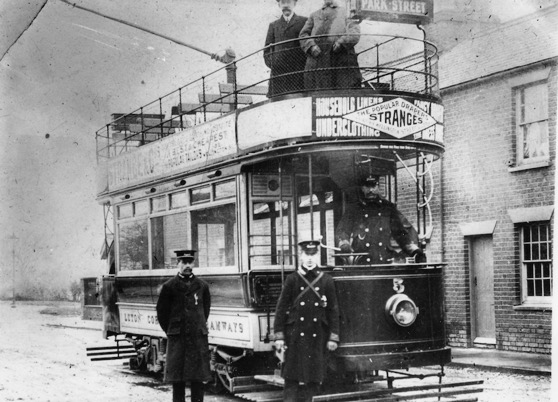
An inspector, a conductor and a motorman pose with Tramcar No 5 at the Round Green terminus — photo undated, but in view of the pristine condition of the tramcar, very probably taken in the first year of operation, i.e., 1907. Author's Collection.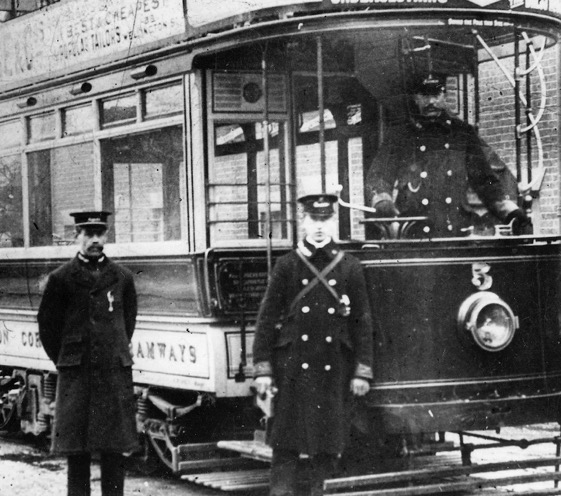
An enlargement of the above photograph showing the tramway staff. The conductor and the motorman are both wearing double-breasted greatcoats, along with tensioned-crown peaked caps bearing script-lettering grade badges; the caps also bear a small badge of unknown pattern, more than likely incorporation the Luton municipal device.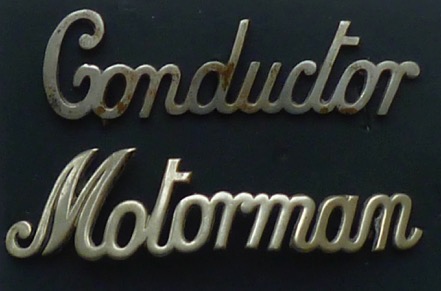
Standard 'off-the-shelf' script-lettering cap badges — nickel. It is believed that Luton insignia were nickel, though this is by no means proven. Author's Collection.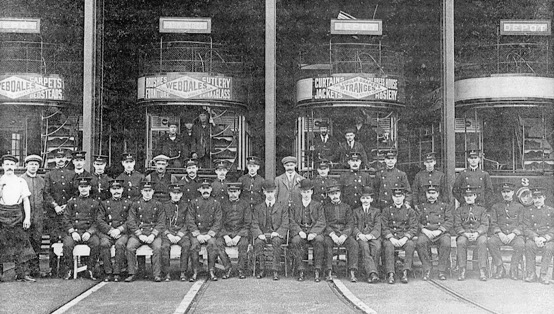
A staff photograph taken at Park Street depot to commemorate the opening in 1908. Photo courtesy of Colin Brown.
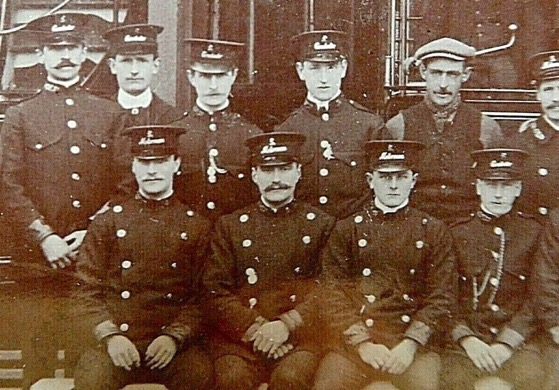
An enlargement of the above photograph showing some of the motormen (in double-breasted, lancer-style tunics) and the conductors (in single-breasted jackets). The small badge above the script-lettering grade badge is a standard Luton 'seven ears of wheat' municipal device (see below).
Luton 'seven ears of wheat' cap badge — nickel. This pattern of badge is almost certainly that used on tramway employee uniform caps, though whether they were nickel or brass is unknown. The badge was also used by other municipal departments, including Luton Borough Police. Author's Collection.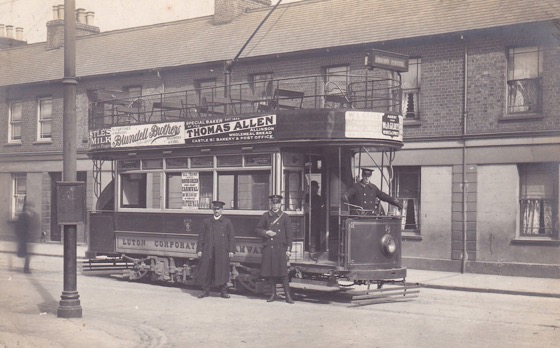
An inspector and the crew of Tramcar No 8 pose for the camera at Round Green — photo undated, but probably taken during the late-Edwardian era. Author's Collection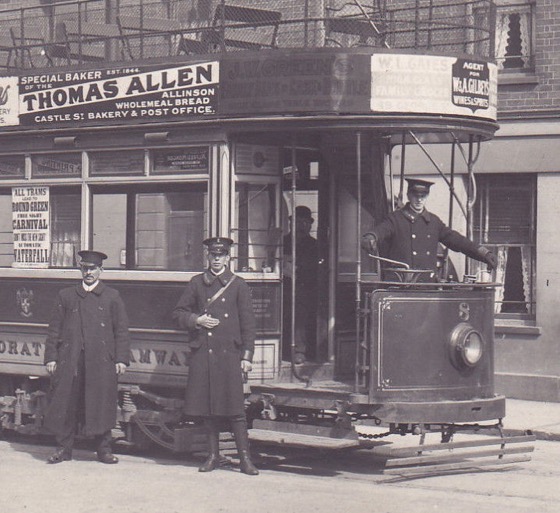
An enlargement of the above photograph showing the tramway staff. The conductor and the motorman are both wearing double-breasted greatcoats with badges on both collars.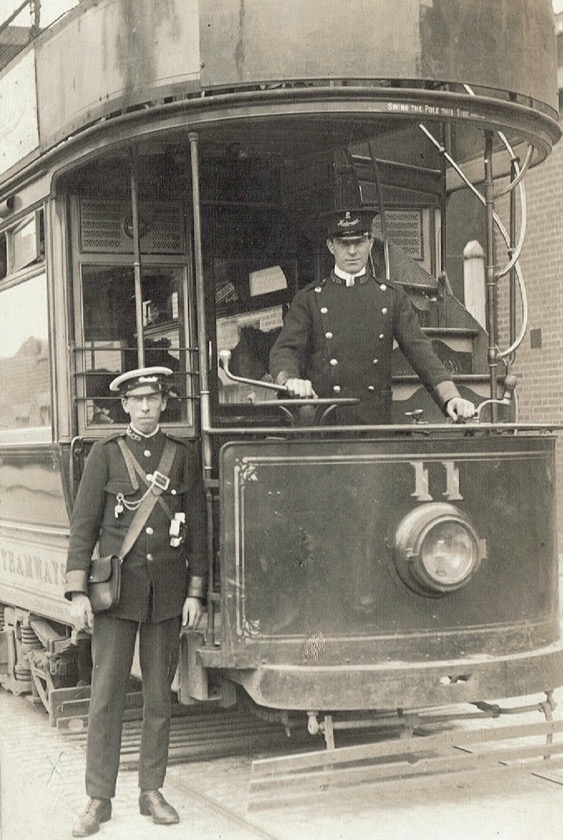
A conductor and a motorman with Tramcar No 11 — photo undated, but possibly taken shortly before the Great War. Closer inspection of this photo indicates that the small cap badge was a Luton 'seven ears of wheat' design, which was also worn by police officers. Source unknown.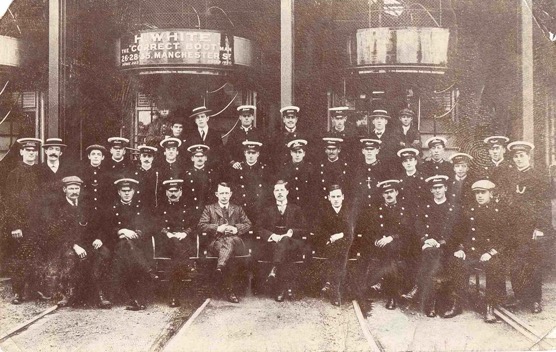
A staff photograph taken at Park Street depot, probably shortly before the Great War, given that the trams are evidently still in very good condition. There are 12 motormen, six conductors, an inspector, a chief inspector and several individuals of uncertain grade. Some of the conductors are wearing lancer-style tunics and some of the motormen single-breasted jackets. Author's Collection.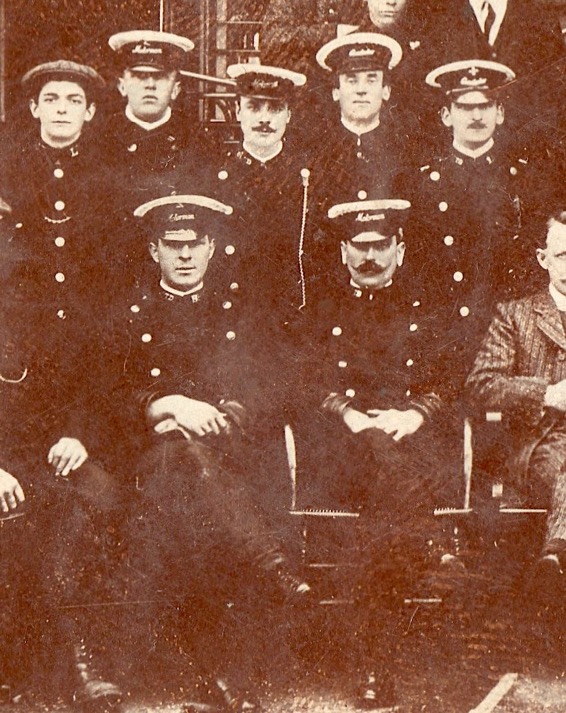
An enlargement of the above photograph showing four motormen, two conductors and a flat-capped individual who may also be a conductor. The collar badges are individual company initials — BB&CoLTD — worn on both sides.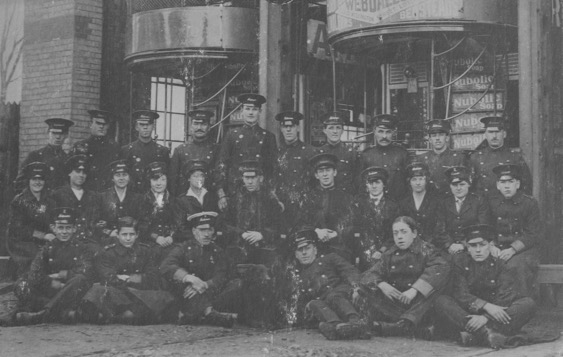
A staff photograph taken at Park Street depot during the Great War, probably late on in the conflict in view the poor state of the trams, the number of women, and the two Silver Wound badges (back row, third and fifth from the left). Author's Collection.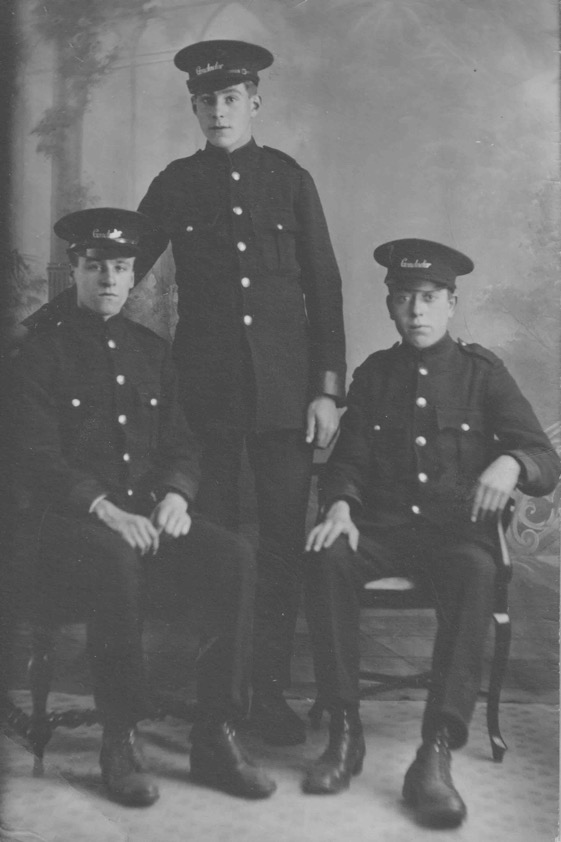
A studio portrait of three young LCT conductors — photo undated, but almost certainly taken during the Great War. None of those depicted are wearing collar insignia. Author's Collection.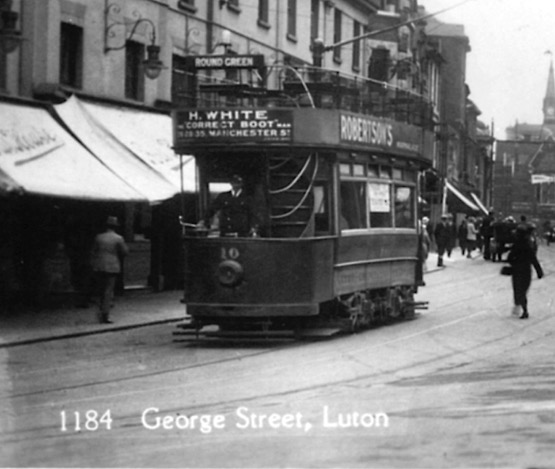
A distinctly hog-backed Tramcar No 10 in George Street — photo undated, but definitely taken after the corporation take-over of 1923. The motorman is wearing a double-breasted jacket with lapels, along with a shirt and a tie. Photo courtesy of the Tramways and Light Railway Society, with thanks to David Voice.
Luton 'seven ears of wheat' cap badge — chrome. This pattern of badge is very slightly larger than the nickel example above, and its use almost certainly post-dates the demise of the tramway (for example, on police and/or ambulance uniforms). Author's Collection.
Senior staff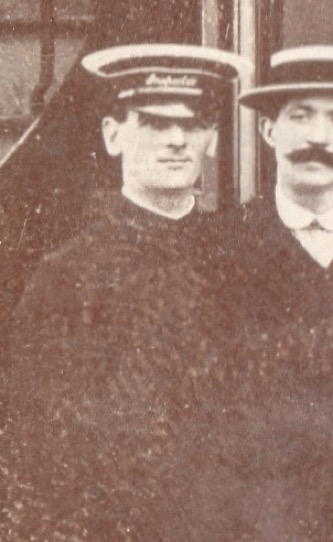
An enlargement of the pre-war depot photograph above showing the inspector. His cap clearly bears an embroidered grade badge on a hat band, bordered with light-coloured piping. Whilst his stand-up collars appear to bear no insignia, this is more than likely a consequence of the poor quality of the photograph.
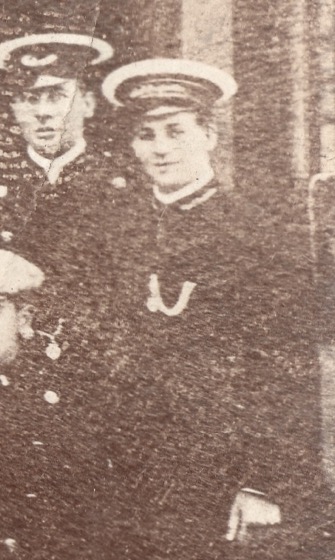
Another blow-up of the 1920's staff photograph, this time showing an individual who, from the length of his grade badge, is possibly the chief inspector.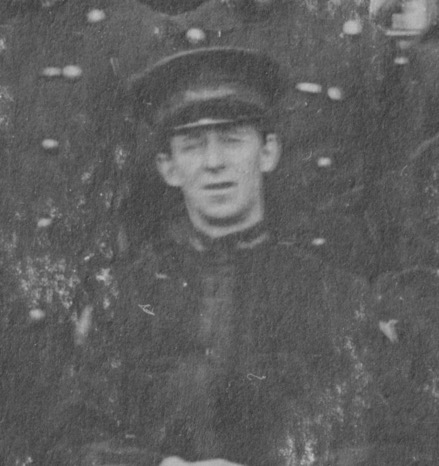
An enlargement of the Great War depot photograph above showing the inspector. His collars bear the grade in embroidered script lettering.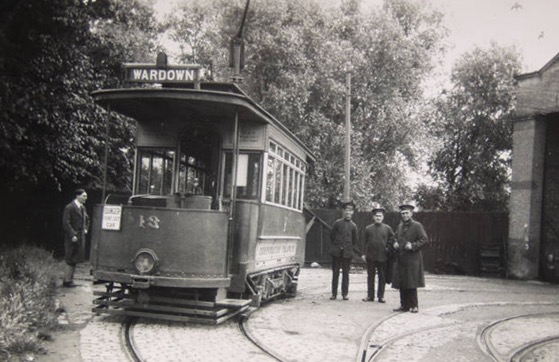
One-man operated Tramcar No 13 photographed at the depot, along with what would appear to be three inspectors — photo undated, but almost certainly taken shortly after 21st May 1923, when No 13 was purchased from Glasgow. Photo courtesy of the Tramways and Light Railway Society, with thanks to David Voice.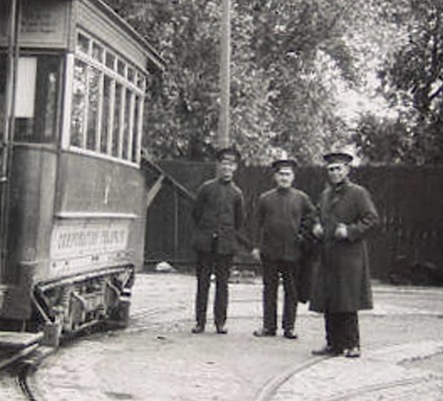
An enlargement of the above photograph showing the inspectors, one in a single-breasted overcoat and the other two in fairly standard 'tramway' inspector jackets.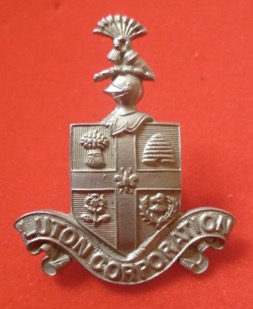
A cap/lapel badge which is believed to have been used in the days of Luton Corporation Transport, i.e., after the demise of the trams — nickel. Although there is a very real possibility that it was first used following the take-over of tramway operation by the corporation in 1923, photographic evidence that would either prove or refute this is yet to come to light. Author's Collection.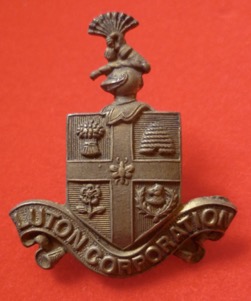
A cap/lapel badge which may have been used in the days of Luton Corporation Transport — brass. It is currently unclear whether this type of badge (or material) was used in tramway days. Author's Collection.
Female staff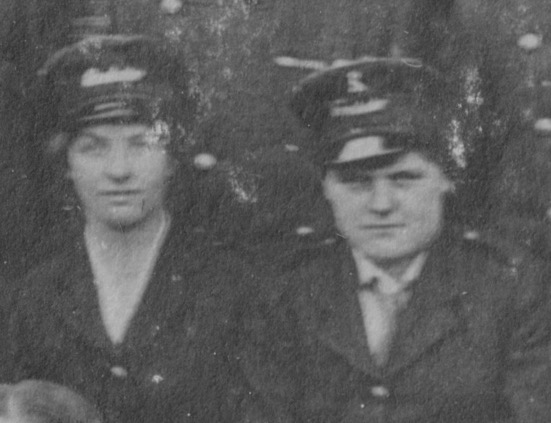
An enlargement of the Great War depot photograph above showing two of the conductresses. Both ladies are wearing script-lettering grade badges, the lady on the right supplementing this with a municipal 'seven ears of wheat' badge.